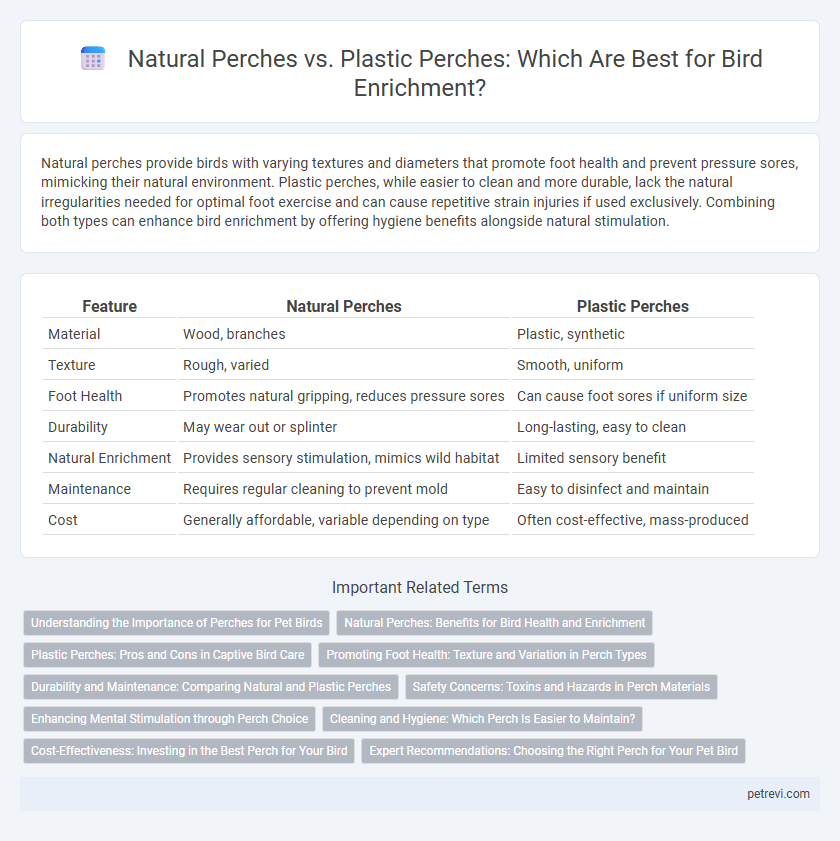Natural perches provide birds with varying textures and diameters that promote foot health and prevent pressure sores, mimicking their natural environment. Plastic perches, while easier to clean and more durable, lack the natural irregularities needed for optimal foot exercise and can cause repetitive strain injuries if used exclusively. Combining both types can enhance bird enrichment by offering hygiene benefits alongside natural stimulation.
Table of Comparison
| Feature | Natural Perches | Plastic Perches |
|---|---|---|
| Material | Wood, branches | Plastic, synthetic |
| Texture | Rough, varied | Smooth, uniform |
| Foot Health | Promotes natural gripping, reduces pressure sores | Can cause foot sores if uniform size |
| Durability | May wear out or splinter | Long-lasting, easy to clean |
| Natural Enrichment | Provides sensory stimulation, mimics wild habitat | Limited sensory benefit |
| Maintenance | Requires regular cleaning to prevent mold | Easy to disinfect and maintain |
| Cost | Generally affordable, variable depending on type | Often cost-effective, mass-produced |
Understanding the Importance of Perches for Pet Birds
Natural perches made from untreated wood provide essential benefits such as promoting healthy feet by varying diameter and texture, which helps prevent pressure sores and arthritis in pet birds. In contrast, plastic perches often have uniform surfaces that can cause foot fatigue and are less effective in stimulating natural behaviors like chewing and climbing. Providing diverse, natural perches is crucial for bird enrichment, supporting both physical health and mental well-being in captive birds.
Natural Perches: Benefits for Bird Health and Enrichment
Natural perches provide essential benefits for bird health by mimicking the varied textures and diameters found in their natural habitats, promoting proper foot exercise and preventing pressure sores or arthritis. The irregular surfaces of natural wood encourage natural behaviors such as chewing and climbing, which enhance mental stimulation and reduce boredom. Incorporating branches from untreated, non-toxic trees supports beak maintenance and overall enrichment, fostering a healthier and more active bird lifestyle.
Plastic Perches: Pros and Cons in Captive Bird Care
Plastic perches offer durability and easy cleaning, reducing the risk of bacterial buildup in captive bird environments. They provide consistent texture and shape, which can help prevent foot injuries but may lack the natural variation needed for optimal foot health and stimulation. Overreliance on plastic perches can lead to foot problems such as pressure sores, making it essential to balance them with natural perches for effective bird enrichment.
Promoting Foot Health: Texture and Variation in Perch Types
Natural perches provide varied textures and diameters that promote healthy foot muscles and prevent pressure sores by mimicking branches found in birds' natural habitats. Plastic perches, while easy to clean and durable, often lack the necessary texture variation, which can lead to foot problems like arthritis or bumblefoot over time. Integrating different perch types, including natural wood with uneven surfaces, enhances foot strength, stimulates natural gripping behavior, and supports overall avian foot health.
Durability and Maintenance: Comparing Natural and Plastic Perches
Natural perches offer superior grip and promote healthy feet but require frequent cleaning and replacement due to wear and possible harboring of bacteria. Plastic perches provide exceptional durability with easy maintenance, resisting cracking and moisture damage, but may lack the texture variety essential for foot health. Choosing between them depends on balancing long-term durability with the need for natural foot exercise and hygiene in bird enrichment.
Safety Concerns: Toxins and Hazards in Perch Materials
Natural perches offer a safer option for bird enrichment compared to plastic perches, as they are free from harmful chemicals and toxins that can leach from synthetic materials. Plastic perches may contain BPA, phthalates, and other hazardous substances that pose long-term health risks to birds through ingestion or skin contact. Natural wood perches also reduce the likelihood of foot sores and provide a non-slip surface, minimizing injury risks associated with slippery plastic.
Enhancing Mental Stimulation through Perch Choice
Natural perches offer varied textures and shapes that simulate a bird's natural environment, enhancing mental stimulation by encouraging natural behaviors like foraging and gripping. In contrast, plastic perches provide uniform surfaces that may reduce sensory engagement and fail to promote cognitive enrichment effectively. Choosing diverse natural perches supports neurological health and prevents boredom in captive birds by engaging their problem-solving abilities and physical dexterity.
Cleaning and Hygiene: Which Perch Is Easier to Maintain?
Natural perches, made from untreated wood or branches, offer a rough texture that helps birds maintain their nails and beaks but can harbor bacteria and require thorough scrubbing to prevent mold growth. Plastic perches provide a smooth, non-porous surface that resists dirt and bacteria buildup, making them easier to clean and disinfect regularly. Choosing plastic perches can enhance hygiene and reduce the risk of infections by simplifying maintenance routines.
Cost-Effectiveness: Investing in the Best Perch for Your Bird
Natural perches offer superior cost-effectiveness by promoting better foot health and reducing vet bills associated with foot problems, making them a valuable long-term investment. Plastic perches, while initially cheaper, often wear out quickly and may contribute to foot issues, resulting in higher replacement and medical expenses. Choosing high-quality natural wood perches balances price with durability and bird comfort, optimizing overall enrichment and wellbeing.
Expert Recommendations: Choosing the Right Perch for Your Pet Bird
Experts recommend natural perches over plastic perches for bird enrichment due to their ability to promote healthier foot muscles and prevent pressure sores. Natural perches made from untreated wood provide varied textures and diameters that encourage natural perching behavior and exercise. Choosing the right perch involves selecting species-specific wood types and ensuring size diversity to support optimal bird foot health and mental stimulation.
Natural perches vs Plastic perches for Bird enrichment Infographic

 petrevi.com
petrevi.com